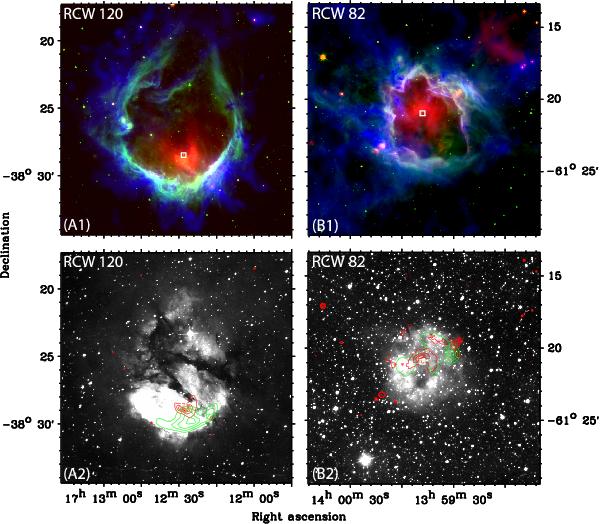Fig. 1

In A1) H II bubble RCW 120 is ionized by a central source (white square) of spectral type O6V–O8V (Zavagno et al. 2007; Martins et al. 2010). Spitzer/IRAC observations at 8 μm (green) trace PAH emission from the inner edge of the bubble, while arc-shaped 24 μm emission from large ~100 K dust grains, as seen by Spitzer/MIPS, peaks close to the central star (red). The Herschel/SPIRE 250 μm observations are plotted in blue, revealing high column densities of cold (~15–30 K) dust surrounding the bubble. Sequential star formation can occur in the swept-up material because the shells are prone to gravitational instabilities (Zavagno et al. 2007; Pomarès et al. 2009; Martins et al. 2010). The shell appears to be broken towards the top. A2) Hα SuperCOSMOS image, overlaid with contours of Spitzer/MIPS 24 μm (red) and NVSS radio continuum emission at 1.4 GHz (green), revealing the distribution of gas and dust inside the bubble. Contour levels are max –80% –60% –40%. In B1) and B2) RCW 82 is ionized by two stars of spectral type O7V–B2V (Pomarès et al. 2009). Images B1) and B2) use the same color scheme as A1) and A2), respectively. The radio continuum data for RCW82 are taken from SUMSS at 843 MHz with contour levels max –80% –60% –40%. In this case, the bubble appears to be broken towards the bottom.
Current usage metrics show cumulative count of Article Views (full-text article views including HTML views, PDF and ePub downloads, according to the available data) and Abstracts Views on Vision4Press platform.
Data correspond to usage on the plateform after 2015. The current usage metrics is available 48-96 hours after online publication and is updated daily on week days.
Initial download of the metrics may take a while.


